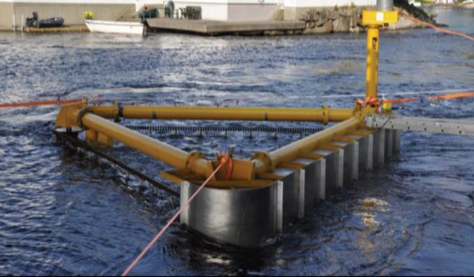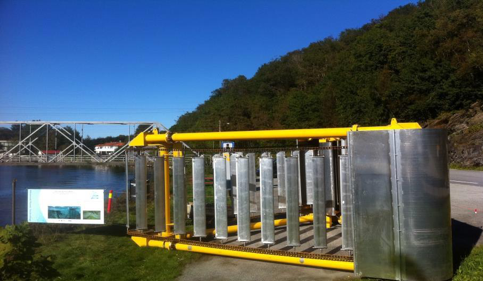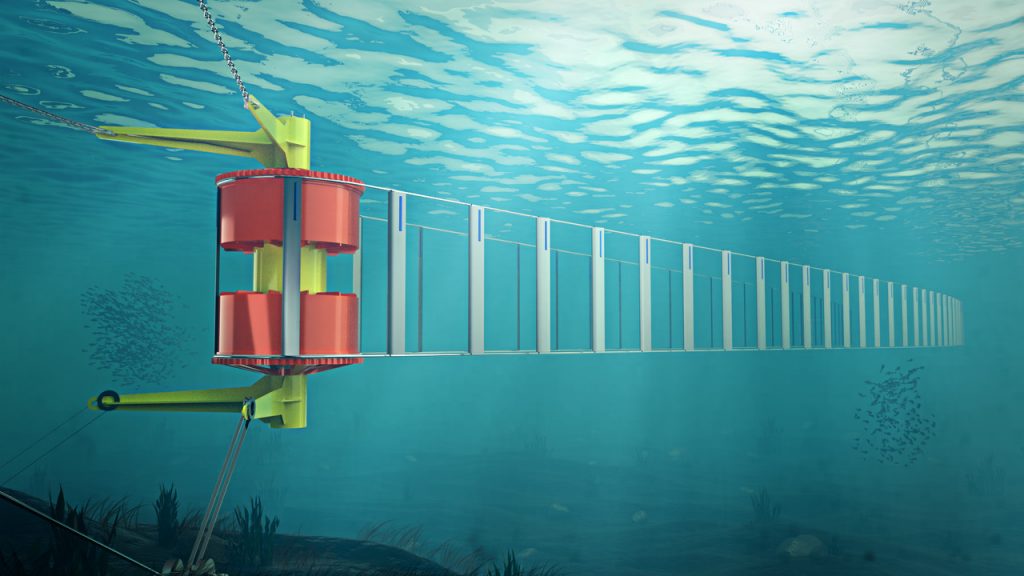Our History
The idea of “sailing the tide” came about during a 2003 fall regatta as the leading boat sailing into a tidal current coursing through a narrow sound. Despite the wind powering the spinnaker from astern, the sleek and polished hull slowed the boat to a halt.
We trimmed the sails to acquire slow-speed control of the vessel but to no avail. Having lost our great lead we resigned ourselves to drifting with the current when it dawned upon me—what if we turned the sailboat upside down, letting the spinnaker catch the tidal stream? Instead of the wind, it would be the tide powering our sails.
We patented the original idea, later dubbed “Classic” PCT/NO2004/000367 (Figure 7 and Figure 8) ultimo 2003. It was a complex, primarily drag based design of a ropeway plant running suspended loops across two stations. The Classic encompassed continuous deployment, attachment, detachment, and storage of 1000 sails to/from the two station magazines each tidal cycle. The first prototype was finally deployed in Skjoldastraumen in 2007, but the design failed to meet expectations.
Tidal Sails 1st generation was abandoned towards the end of the Eurostars project, and the remaining budget was allocated towards the development of a new three-station solution: “Triangle” PCT/NO2010/. Triangle showed promise and even exceeded the Betz limit with its two reaching legs, but it came with the disadvantage of a more complex mooring system. The Tidal Sails 2nd generation Triangle was classified as an EU-Success Story in 2012.
Following years of additional testing and improvements, the 3rd generation “TackReach” came about in 2015. Returning to the two-station setup, TackReach was presented as a “Self-Adjustable and Variable Pitch Sail Control System”; PCT/NO2012/050178 was boldly implemented in our new TackReach prototype, which was grid-connected in Skjoldastraumen in 2016. The diagonal orientation of the plant in the current was key to ensuring appropriate spacing between the two sail legs, as the tacking sails generated substantially more sideways pull.
As avid Europe and Laser dinghy sailors, we could acknowledge from the beginning the speed-sailing superiority of beam reach—sailing perpendicularly to the wind. But at the time we found no way of preventing the sail legs from crashing into each other. In 2019, after 15 years of seeking a solution that could handle a multitude of configurations, we were proud to introduce “BeamReach”, Tidal Sails 4th generation.
With its superior energy trapping ability, BeamReach exerts the least mooring loads, yields the highest efficiency, and represents the lowest cost to capacity ratio—far below any known competitors. Over the past year, BeamReach has endured excessive modeling and scrutiny, and its third iteration with asymmetric sails has finally been submitted for patenting.


TidalSails “Classic”, first prototype deployed in 2007, abandoned in 2009


Tidal Sails “Triangle”prototyping in 2011, abandoned in favor of TackReach in 2015.
The NEW refined BeamReach solution!
The radical, patented
technology platform to extract clean energy from “slow moving water” of
tidal streams, rivers and ocean currents has become the crescendo of 15years of
successive innovations by Tidal Sails AS.
BeamReach combines ancient principles of ocean sailing with state of the art alpine ropeway technology. The patented “sweet spot” configuration will surpass all known tidal technologies as regards extraction efficiency, cost to capacity ratio and environmental friendliness.
A typical plant infrastructure consists of 4-600 Aluminium sails (wings) attached to two steel wire rope loops strung between two freely suspended Direct Drive Generator Stations.
The sails pull the ropes by reaching the first leg before jibing about the opposite station and then reaching back to the first station, while rotating the 4 large direct drive generators

BeamReach exposes a significantly larger surface area into the energy stream than any other known tidal energy technology, but yield the same efficiency per area as typical tidal turbines,
The Full Scale demonstration with loops of 500 m length will be deployed in a natural laminar tidal current of about 2m/s or 4 knots, well below what is presently considered attractive by competing technologies.
The plant will be connected to the 22kV Hammerfest Energi power grid, less than 100 meters from the plant. Further, the project will provide in-depth information on installation, operations and decommissioning costs, as well as “reliability and survivability” in the harsh climate of the arctic.
The project has been awarded a Permit from the Norwegian Water Resources and Energy Directorate (NVE), a Power Purchase Agreement and Letter of Support with Hammerfest Energi, and an Exclusive Sponsorship Agreement with the Norwegian Coastal Administration, incorporating three man months into the project free of charge!
BeamReach latest iteration produces power on both legs employing asymmetric sails, which inherently assures adequate spacing between the upstream and downstream legs, while increasing the overall plant efficiency by 20%. No loss on the upstream leg and 40% gain on the downstream leg.
The relatively higher sideways load generated by the asymmetric sails on the downstream leg yields a greater horizontal catenary than the inverted sails inflict on the upstream leg. This elegantly assures safe spacing between the two legs, and minimize the inherent “Fence Effect” of the first row of sails, identified via the “Gyda” test rig in 2011, leaving a relatively untapped energy stream for the downstream leg.
Well before the ropeway load capacity is challenged by the high sideways load a high Angle of Attack provokes, each individual sail autonomously decreases pitch, thus reducing excessive sideways load. In strong currents with concurrent high sideways loads, excess power is bled off in order not to compromise structural integrity of the ropeway system (similar to a yachtsman easing out his main sail in order to not overpower his heeling sailboat in strong winds).
In order to completely flatten the power curve individual sails will be disengaged by the control system within 0,5% power accuracy from nominal power. This “Peak Shaving” capacity is imperative to achieve the high annual production, which distinguish Tidal Sails from other concepts.
